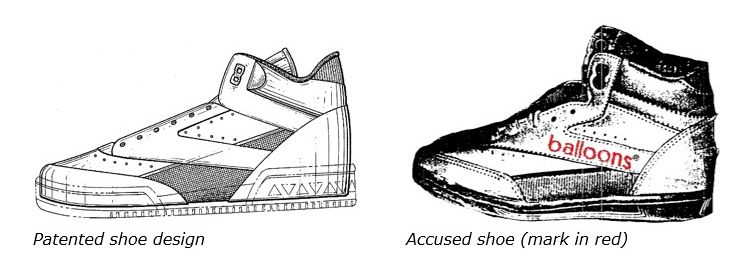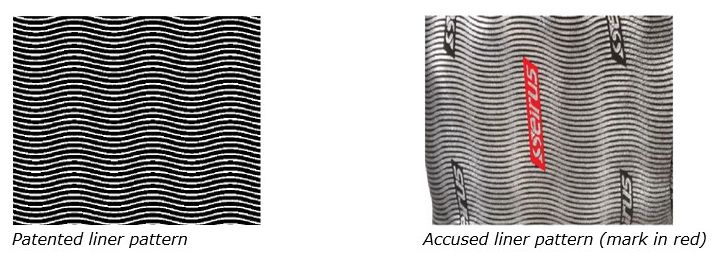Jury verdict underscores the necessity of coordinating trademark and design patent portfolios.
For nearly 30 years, the inclusion of a trademark in the design of a defendant's product did not mean much in the design patent infringement analysis. That changed on August 6, 2021, in Columbia Sportswear North America, Inc. v. Seirus Innovative Accessories, Inc., when a jury considered, among other things, whether a trademark's appearance and placement might "give an ordinary observer a different visual impression" than the patented design. 3:17-cv-01781 (S.D. Cal Aug. 6, 2021). The jury rendered a verdict that the accused design that included a trademark did not infringe the design patent at issue.
The verdict in Columbia departs from long-standing Federal Circuit precedent. In L.A. Gear v. Thom McAn Shoe Co., 988 F.2d 1117, 1126 (Fed. Cir. 1993), the Federal Circuit held that including a mark or labelling does not avoid design patent infringement as shown in the following shoe design and accused shoe:

The holding in L.A. Gear meant for many years that the presence of a trademark is not an absolute defense to design patent infringement. A would-be infringer should not achieve "avoidance of infringement by labelling." Id.
Fast forward to the Columbia and Seirus dispute. Columbia sued its rival Seirus for infringing its design-patented surface pattern for a heat reflective material used in liners for gloves and sleeping bags:

Relying on L.A. Gear, the district court disregarded the "labelling" here, the SEIRUS trademark, and granted summary judgment of infringement to Columbia. The Federal Circuit reversed, reasoning that a fact finder cannot "ignore elements of the accused design entirely, simply because those elements included the name of the defendant." Id. at 1131. Instead, a jury should "consider[] an ornamental logo, its placement, and its appearance as one among other potential differences between a patented design and an accused one." Id. The Federal Circuit concluded that the district court had made impermissible factual findings as to "whether an element of Seirus's design would give an ordinary observer a different visual impression than Columbia's design," and returned the case to the district court for a trial on infringement. Id.
On remand, the jury rendered a verdict that Seirus's design did not infringe Columbia's design patent. The district court entered judgment on August 10, 2021. Post-judgment motions will be due in early September, and an appeal to the Federal Circuit may follow after that.
The immediate takeaway from Columbia v. Seirus is this: A trademark in a design could limit liability for design patent infringement. Thinking carefully about how trademarks and design patents relate to each other is important and can have a significant impact on certain types of designs, particularly those where logo and brand name treatments can be visually prominent. In all events, coordinating brand and design patent portfolio development and potential enforcement remains critical.
The content of this article is intended to provide a general guide to the subject matter. Specialist advice should be sought about your specific circumstances.
Mr Gregory Castanias
Jones Day
51 Louisiana Avenue, N.W
Washington, DC
20001-2113
UNITED STATES
Tel: 2165863939
Fax: 2165790212
E-mail: info@JonesDay.com
URL: www.jonesday.com
© Mondaq Ltd, 2021 - Tel. +44 (0)20 8544 8300 - http://www.mondaq.com, source Business Briefing



